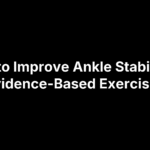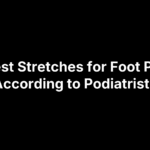Sharp heel twinges on your first steps out of bed, a dull ache in your arches after a long shift, or burning under the ball of your foot after a run—foot pain can derail your day fast. While causes range from overuse and unsupportive shoes to tight calves, plantar fasciitis, or minor sprains, the good news is that most everyday foot pain responds to simple, consistent home care. The key is choosing the right strategies, doing them safely, and knowing when a “sore foot” is actually a sign to get expert help.
This guide shares eight podiatrist-approved home remedies to reduce strain, calm inflammation, and restore comfortable movement. You’ll get clear, step-by-step instructions, pro tips and common mistakes to avoid, plus red flags that mean it’s time to see a specialist at Achilles Foot and Ankle Center. From smart rest and activity tweaks to ice and compression, targeted stretches and strengthening, better shoe support, massage, and night splints or taping for plantar fasciitis and Achilles pain—we’ll help you feel better, faster. First up: a quick self-check to match your symptoms with the right next steps.
1. Start with a quick self-check – and when to see Achilles Foot and Ankle Center
Before you ice, stretch, or buy inserts, take two minutes to map your symptoms. A quick self-check helps you match the right home remedies for foot pain to what’s most likely going on—and spot any red flags that need expert care.
Why it helps
Different pain patterns point to different tissues. Knowing where it hurts, when it flares, and what makes it better or worse guides targeted, safer self-care and speeds relief.
Step-by-step at home
Start with a simple scan of location, timing, and triggers.
- Pinpoint location: Heel, arch, ball, toes, top, or side of foot.
- Morning first-step pain: Often linked to plantar fasciitis (heel/arch).
- Back-of-heel pain with activity: Common in Achilles tendonitis.
- Top-of-foot ache/swelling: Can be sprain, tendonitis, or gout.
- Outside-of-foot soreness after mileage jump: Consider stress injury.
- Burning/tingling or numbness: Think nerve irritation or neuropathy.
Pro tips and common mistakes
A few smart tweaks make your self-check more reliable.
- Note patterns: Onset, activities, shoes worn, and what eases pain.
- Inspect footwear: Worn-out soles or poor support worsen symptoms.
- Ice safely: Use a cloth-covered pack—never ice directly on skin.
- Don’t “stretch through” sharp pain: Gentle only; stop if it spikes.
When to stop and see a podiatrist
Self-care isn’t for every situation. Seek prompt help if you notice:
- Pain lasting > 2 weeks without improvement.
- Sudden/severe pain or pain after an injury or twist.
- Inability to bear weight or suspected fracture/deformity.
- Signs of infection: Redness, warmth, swelling, fever, open wound.
- Numbness/tingling/burning or progressive weakness.
- Any new foot issue if you have diabetes or poor circulation.
Achilles Foot and Ankle Center offers comprehensive evaluation and same-day appointments when you need them most.
2. Reduce strain now with rest and activity modification
When your feet are barking, the fastest win is to take the load off the irritated tissues. Smart, short-term “relative rest” and a few activity tweaks can dial down pain quickly without derailing your routine—and it’s one of the simplest home remedies for foot pain to start today.
Why it helps
Most everyday foot pain stems from overuse, poor support, or sudden activity changes. Easing the repetitive stress gives inflamed tissues time to calm down, reduces micro‑trauma, and prevents a small ache (like plantar fasciitis or tendonitis) from snowballing into a bigger injury.
Step-by-step at home
Begin by trimming the stressors, not your entire life—keep moving, just move smarter.
- Pause impact triggers: Temporarily avoid running, jumping, hills, and long periods of standing that flare symptoms. Resume only as pain settles.
- Cross-train with low impact: Swap in swimming, cycling, or yoga to stay active while your foot heals.
- Breaks and pacing: Use short sit breaks during long standing shifts and split errands into smaller walks.
- Modify terrain and tasks: Choose flat, even surfaces and spread out high-demand chores over the week.
- Use supportive footwear now: Wear cushioned, supportive shoes around the house and at work; skip high heels and flimsy sandals.
- Progress gradually: When improving, reintroduce impact slowly; back off if pain spikes during activity or lingers the next day.
Pro tips and common mistakes
Small changes add up—these keep you moving in the right direction.
- Do: “Relative rest,” not total downtime—complete inactivity can stiffen tissues.
- Do: Rotate activities to avoid repeating the same stress day after day.
- Don’t: Push through sharp pain or try to “make up” missed workouts.
- Don’t: Rely on worn‑out shoes—retire pairs that have lost cushioning or support.
When to stop and see a podiatrist
Activity changes should ease symptoms within days. Seek care promptly if you have:
- Pain lasting longer than two weeks without improvement.
- Sudden or severe pain, or pain after a twist or fall.
- Inability to bear weight or visible deformity.
- Redness, warmth, swelling, or fever, or any open wound.
- Diabetes or circulation problems with any new foot issue.
If in doubt, Achilles Foot and Ankle Center can tailor a safe return‑to‑activity plan and rule out hidden injuries.
3. Calm pain and swelling with ice, elevation, compression, and OTC relief
When soreness shows up, a simple plan can quickly take the edge off: cool it down, take pressure off, add gentle compression, and consider short-term over‑the‑counter pain relief. This “first aid” bundle is one of the most effective home remedies for foot pain, especially after long days on your feet or a spike in activity.
Why it helps
Most foot flare-ups involve irritated soft tissues and swelling. Cooling reduces inflammation and numbs tender areas; elevating limits fluid pooling; compression helps control swelling and supports tired tissues; and OTC pain relievers ease pain (and, with NSAIDs, inflammation) so you can move more comfortably while you heal.
Step-by-step at home
Start with brief, consistent sessions and adjust to symptoms rather than the clock.
- Ice: Use a cloth‑covered ice pack on the sore spot for about 15 minutes, 2–4 times daily. Or roll your arch over a frozen water bottle for targeted relief.
- Elevate: When you can, sit or lie down with feet propped on pillows to reduce swelling—especially after activity or at day’s end.
- Compress: Wear a light elastic wrap or compression socks to manage swelling and add support. It should feel snug, not painful or tingly.
- OTC pain relief: Use acetaminophen for pain, or an NSAID like ibuprofen/naproxen for pain and inflammation. Follow the label, and don’t take NSAIDs for more than 10 days without talking to your doctor. Topicals with menthol or lidocaine can add spot relief.
Pro tips and common mistakes
A few small tweaks make these tools work better—and safer.
- Cover the skin: Always place a thin cloth between ice and skin.
- Time it right: Ice after activity and in the evening to curb next‑day stiffness.
- Match heat to the problem: Use ice for redness/swelling; reserve gentle heat only for muscle tightness.
- Go snug, not tight: If compression causes numbness or color change, loosen it.
When to stop and see a podiatrist
These steps should ease symptoms within days. Get prompt care if you have:
- Pain that persists beyond two weeks without improvement
- Sudden/severe pain or pain after a twist or fall
- Inability to bear weight or a visible deformity
- Redness, warmth, swelling with fever, or an open wound
- Any new foot issue if you have diabetes or poor circulation
4. Stretch smarter: calves, plantar fascia, toes, and ankles
Tight calves and stiff foot tissues pull on sore spots with every step. A short, consistent mobility routine can reduce morning “first‑step” pain, ease all‑day aching, and make every other home remedy for foot pain work better. Go gentle, move often, and aim for steady progress over deep, aggressive stretches.
Why it helps
Calf and plantar fascia tightness increase strain on your heel and arch with walking and standing. Gentle, frequent stretching improves flexibility, reduces tension on irritated tissues (like in plantar fasciitis), and helps restore a smoother stride. Simple toe and ankle mobility also wards off cramping and stiffness.
Step-by-step at home
Do this quick sequence once or twice daily, and before longer periods on your feet.
- Standing calf wall stretch (straight leg): Step one foot back, heel down, toes forward. Lean into the wall until you feel a mild calf stretch. Hold 30–60 seconds, 2–3 times each side.
- Seated towel stretch (arch/plantar fascia): Loop a towel or strap around the ball of your foot. Pull gently until you feel a stretch in the arch and calf. Hold 30 seconds, 2–3 times.
- Toe and ankle mobility: While seated, point and flex the toes, then make slow ankle circles both directions for 30–60 seconds.
- Morning wake‑up: Before getting out of bed, do 10–15 ankle pumps and gentle toe curls to reduce first‑step pain.
Pro tips and common mistakes
A few form cues make these stretches safer and more effective.
- Stretch to mild tension, not pain; never bounce or force range.
- Keep the back heel flat and toes forward during the calf stretch.
- Use a towel/strap if ankle motion is limited—don’t round your back to “get there.”
- Be consistent, not intense: short daily sessions beat occasional deep stretching.
When to stop and see a podiatrist
Pause and get expert help if stretching causes sharp pain, numbness or tingling, your pain doesn’t improve after two weeks of consistent work, or you have diabetes or circulation issues with any new foot symptoms. Early guidance can prevent small problems from becoming bigger ones.
5. Strengthen your feet and ankles with simple at-home exercises
When pain calms a bit, build resilience. Gentle strengthening supports your arches and ankles so they tolerate daily miles better and reduce repeat flare-ups. You don’t need a gym—short, consistent sessions are effective and pair perfectly with the other home remedies for foot pain you’re already using.
Why it helps
Weak or tired foot and calf muscles shift extra load onto irritated tissues like the plantar fascia and tendons. Strengthening improves support and control with each step, making walking and standing more comfortable and reducing the risk of overuse pain returning.
Step-by-step at home
Start with low effort, slow movements, and focus on good form rather than big resistance.
- Easy walks for foot health: Take short, comfortable walks in supportive shoes to keep feet limber and strong.
- Towel curls (arches/toes): While seated, place a small towel on the floor. Use your toes to scrunch and pull it toward you, then relax and repeat.
- Marble pickups (intrinsic muscles): Place a few marbles on the floor next to a cup. Pick up one marble at a time with your toes and drop it in the cup, then switch feet.
- Resistance-band ankle work (ankle strength): Anchor a band to sturdy furniture. Loop it over your forefoot. Slowly pull your foot toward you against the band, pause, then return with control. Turn 90 degrees to work the ankle in other directions. Repeat several times each way.
Pro tips and common mistakes
Build gradually and listen to your symptoms—slight fatigue is fine, sharp pain isn’t.
- Move slowly and control the return to get more from each rep and protect joints.
- Do short sets, more often—consistency beats intensity.
- Go barefoot for towel/marble drills for better toe engagement; use supportive shoes for walks.
- Skip “no pain, no gain”: If pain spikes during or after, reduce resistance or volume.
When to stop and see a podiatrist
Pause and get expert help if strengthening causes sharp pain, numbness or tingling, visible swelling, you can’t progress after two weeks, or you have diabetes or circulation problems with any new foot symptoms. Achilles Foot and Ankle Center can tailor a safe, targeted plan if exercises keep flaring your pain.
6. Switch to supportive shoes and add arch supports
If your feet hurt, your shoes and insoles are the first place to look. Supportive footwear and the right arch support reduce the repetitive strain that fuels plantar fasciitis, heel pain, and tired arches. Small changes here often deliver the biggest, fastest relief.
Why it helps
Shoes with a stable base, good arch support, and a wide toe box distribute pressure more evenly and limit excessive foot motion. Over‑the‑counter orthotics and custom inserts can further support the arch and heel—both approaches have been shown to improve rear‑foot pain and function—so irritated tissues can calm down.
Step-by-step at home
Start by auditing what you wear most, then upgrade strategically.
- Retire worn pairs: Replace sneakers that feel flat or have uneven tread; many lose support after roughly 400–500 miles.
- Choose key features: Wide toe box, firm heel counter, cushioned midsole, and clear arch support.
- Match shoe to activity: Use athletic shoes for exercise; avoid flimsy sandals for long standing.
- Wear support indoors: Swap barefoot on hard floors for supportive house shoes.
- Test arch supports: Try a neutral or moderate OTC insert; remove the factory insole first and increase wear time gradually.
Pro tips and common mistakes
Dial in fit and form to get more relief from every step.
- Shop late day in your usual socks; feet swell slightly by evening.
- Aim for a thumb’s width of space at the longest toe; no heel slippage.
- Don’t stack inserts or force a high arch if it increases pain.
- Skip high heels and unsupportive flip‑flops; rotate two supportive pairs to let cushioning rebound.
When to stop and see a podiatrist
Footwear changes should start helping within days. Get expert care if:
- Pain persists beyond two weeks or worsens despite better shoes.
- You have sudden, localized pain (especially on the outside of the foot) after a mileage or activity jump.
- There’s numbness, tingling, swelling, or deformity, or you can’t bear weight.
- You have diabetes or poor circulation and any new foot problem.
A podiatrist can confirm the cause, prescribe custom orthotics, and tailor shoe recommendations to your feet and activities.
7. Massage and roll tight tissues to ease soreness
When your feet feel knotted and achy, a few minutes of gentle hands‑on work can unlock stiffness and calm irritation. Massage pairs well with ice and stretching, easing plantar fascia and forefoot tension so walking feels smoother and less painful.
Why it helps
Light pressure increases local circulation, reduces muscle guarding, and desensitizes tender spots without overloading irritated tissues. Rolling the arch with a ball or frozen bottle targets the plantar fascia, a common source of heel and arch pain, while thumb kneading loosens tight areas safely.
Step-by-step at home
Set up a short routine and keep pressure gentle. Try this 1–2 times daily.
- Warm up (optional): A warm foot soak (10–20 minutes; Epsom salt if you like) relaxes tissues before massage.
- Thumb knead the arch: Sit, apply a bit of lotion, and press‑knead from the ball of the foot toward the heel for 60–90 seconds. Use “press, hold, release.” Avoid direct pressure on bony spots.
- Target the heel edges: Use small circular motions along the firm rim around the heel, not directly on the heel bone.
- Ball roll (tennis/golf ball): Roll the sole from toes to heel for 1–2 minutes. Ease up over tender areas; it should feel “good sore,” not sharp.
- Frozen bottle option: For plantar fasciitis flare‑ups, roll the arch over a cloth‑covered frozen water bottle for cooling and massage, about 5–10 minutes.
- Finish with a gentle stretch: Do a brief towel or calf stretch to lock in the gains.
Pro tips and common mistakes
- Aim for comfort, not force: Stop if pain is sharp or worsening.
- Go slow and breathe: Let tissues “melt” under steady, moderate pressure.
- Protect skin: Use a small amount of lotion; avoid if you have open wounds.
- Mind medical conditions: If you have diabetes or poor sensation, keep pressure very light and inspect skin before/after.
- Don’t massage hot, swollen areas: Use ice and elevation first; resume massage when swelling subsides.
When to stop and see a podiatrist
- Pain persists longer than two weeks or worsens despite self‑care
- Sudden/severe pain, inability to bear weight, or suspected fracture
- Redness, warmth, spreading swelling, fever, or any open wound
- Numbness, tingling, or burning that doesn’t settle
- Any new foot problem if you have diabetes or circulation issues
If you’re unsure whether massage is right for your symptoms, a quick visit can pinpoint the cause and tailor safer relief.
8. Use night splints or taping for plantar fasciitis and Achilles pain
Night splints and supportive taping work while you rest. By holding a gentle stretch or sharing load, they often ease morning first‑step pain from plantar fasciitis and calm nagging Achilles tightness—two of the most effective home remedies for foot pain you can do overnight.
Why it helps
Sleeping with feet pointed down shortens the plantar fascia and Achilles. A splint keeps the ankle near 90 degrees for a steady, gentle stretch. Taping adds temporary external support to reduce strain as tissues heal.
Step-by-step at home
Start simple and adjust to comfort.
- Fit near 90°, straps snug without numbness.
- Build from 1–3 hours to overnight as tolerated.
- Pair with gentle morning calf/arch stretches.
- No splint? Use athletic or kinesiology tape to support arch or Achilles.
Pro tips and common mistakes
Keep it comfortable and skin‑friendly.
- Keep a gentle stretch—never force the ankle forward.
- Avoid hot, swollen areas or open wounds; test for tape allergies.
When to stop and see a podiatrist
Stop and get expert help if you notice:
- No improvement after about two weeks.
- Numbness, tingling, color change, blistering, or rash.
- Worsening pain, a sudden “pop,” or trouble pushing off.
- Any new foot issue with diabetes or poor circulation.
The bottom line
Most everyday foot pain improves with a focused routine done consistently—not perfectly. Pair short bouts of relative rest with ice, elevation, light compression, and OTC pain relief as directed. Add daily mobility for calves and plantar fascia, simple strengthening, supportive shoes with the right inserts, and gentle massage or rolling. For plantar fasciitis or Achilles pain, night splints or taping can ease that brutal first‑step ache. Track what helps, progress slowly, and let discomfort—not the calendar—set your pace.
If pain lingers beyond two weeks, is sudden or severe, limits weight bearing, comes with redness or fever, numbness or tingling, or you have diabetes, it’s time for expert care. A podiatrist can confirm the cause and tailor a plan so you heal faster and prevent setbacks. Ready for relief you can trust? Schedule a visit with the team at Achilles Foot and Ankle Center—same‑day appointments are available.






